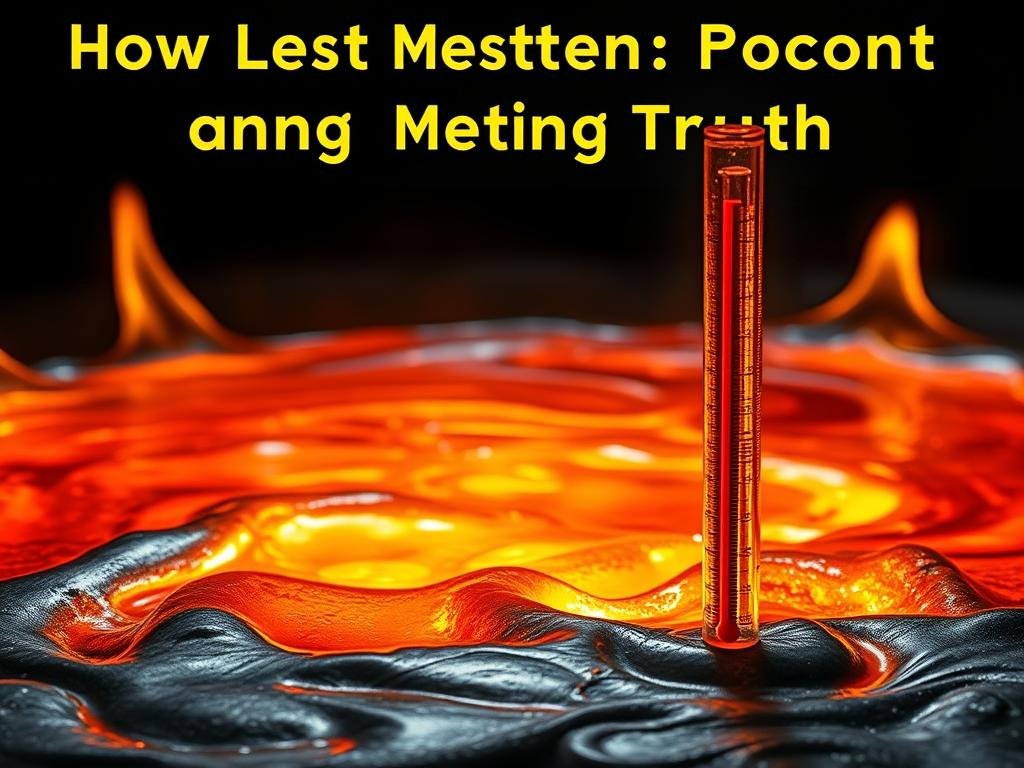The quest to identify the métal with the highest point de fusion leads us to the element tungsten. Tungsten is known for having the highest point de fusion among all métaux, at a scorching 3,422°C (6,150°F).
Comprendre le point de fusion of métaux is crucial in various industrial applications, as it determines their suitability for high-temperature environments. Tungsten’s exceptionally high point de fusion makes it an ideal material for applications where exposure to extreme heat is a factor.
Professionals such as engineers, manufacturers, and scientists rely on knowledge of points de fusion to select the appropriate materials for their projects, ensuring durability and performance under various conditions.
Understanding Metal Melting Points
Understanding the melting points of metals is essential for various industrial processes. The melting point of a metal is a critical property that determines its suitability for different applications.
What Is a Melting Point?
A melting point is the temperature at which a metal changes from a solid to a liquid state. This temperature varies depending on the specific metal and is a crucial characteristic that influences its use in various industries.
Why Melting Points Matter in Industry
Melting points are critical parameters in industrial applications, particularly in manufacturing, aerospace, and energy sectors. Knowledge of melting points helps engineers select appropriate materials for specific temperature environments and affects metal fabrication processes such as casting, welding, and forming.
Which Metal Have Highest Melting Point?
Among all metals, tungsten has the distinction of having the highest melting point, reaching an extraordinary 3,422°C (6,192°F).
Tungsten is a refractory metal known for its exceptional properties, including its high melting point, good high-temperature strength, and resistance to corrosion from molten alkali metals and steam. Its melting point is significantly higher than other metals, making it ideal for applications requiring extreme temperature resistance.
The atomic structure and bonding characteristics of tungsten contribute to its extreme heat resistance. As a refractory metal, tungsten maintains its strength at very high temperatures, only experiencing oxide volatilization and forming liquid phase oxides when heated above 1,000°C.
Tungsten’s unique combination of properties makes it invaluable in various industrial applications, including those that require materials to withstand extremely high temperatures.
Top 10 Metals with the Highest Melting Points
When it comes to withstanding extreme temperatures, certain metals stand out for their exceptionally high melting points. These metals are crucial in various high-temperature applications across industries such as aerospace, electronics, and energy production.
1. Tungsten (W) – 3,422°C (6,150°F)
Tungsten holds the record for the highest melting point among all metals, at 3,422°C (6,150°F). This refractory metal is invaluable in applications requiring extreme thermal stability, such as light bulb filaments, high-temperature furnace components, and aerospace parts.

2. Rhenium (Re) – 3,180°C (5,756°F)
Rhenium is a silver-white, heavy, and dense metal with the second-highest melting point. It’s used in superalloys for jet engine components and in platinum-rhenium catalysts for the petroleum industry.

3. Osmium (Os) – 3,033°C (5,491°F)
Osmium is the densest naturally occurring element and has a high melting point. Its applications are limited due to its toxicity and hardness, but it’s used in fountain pen nibs and electrical contacts.
4. Tantalum (Ta) – 2,966°C (5,371°F)
Tantalum is known for its excellent corrosion resistance and high melting point. It’s used in electronic components, medical implants, and chemical processing equipment.

5. Molybdenum (Mo) – 2,620°C (4,748°F)
Molybdenum is a refractory metal used in steel alloys, catalysts, and high-temperature furnace components. Its high melting point and resistance to corrosion make it valuable in industrial applications.
6. Niobium (Nb) – 2,468°C (4,474°F)
Niobium is a soft, ductile metal with superconducting properties. It’s used in aerospace alloys, superconducting magnets, and high-performance automotive components.
7. Iridium (Ir) – 2,454°C (4,449°F)
Iridium is a dense, brittle metal with extreme corrosion resistance. It’s used in high-performance alloys, spark plugs, and specialized equipment.
8. Hafnium (Hf) – 2,227°C (4,041°F)
Hafnium has a high melting point and is used in nuclear reactors as a neutron absorber. It’s also used in high-temperature ceramics and superalloys.
9. Rhodium (Rh) – 1,964°C (3,567°F)
Rhodium is a rare, silvery-white metal with high reflectivity and catalytic properties. It’s used in catalytic converters, jewelry, and electroplating.
10. Chromium (Cr) – 1,907°C (3,465°F)
Chromium is a hard, silvery-white metal with a high melting point. It’s widely used in stainless steel production, decorative plating, and high-temperature alloys.
Factors That Affect Metal Melting Points
Several factors contribute to determining a metal’s melting point. The melting behavior of metals is a complex phenomenon influenced by various physical and chemical properties.
External Pressure
External pressure is a significant factor that can either increase or decrease a metal’s melting point. Higher pressures typically result in higher melting points due to the compression of atoms, making it more difficult for the metal to change its state from solid to liquid.
Type of Bond
The type of chemical bond present in a metal also plays a crucial role in determining its melting point. Metals with ionic bonding generally have higher melting temperatures than those with covalent bonding, as ionic bonds require more energy to break.
Impuretés et Alliages
La présence d'impuretés ou d'éléments d'alliage peut considérablement modifier le point de fusion d'un métal. Même de petites quantités d'impuretés peuvent perturber la structure cristalline, rendant le métal plus facile à fondre et élargissant la gamme des températures de fusion.
Atomic Structure
La structure atomique et l'agencement d'un métal, tels que cubique à faces centrées, cubique à corps centré ou hexagonal compact, influencent son point de fusion. La force des forces interatomiques, qui est affectée par la taille et la masse atomiques, joue également un rôle crucial dans la détermination du comportement de fusion.
Comprendre ces facteurs est essentiel pour les scientifiques et ingénieurs en matériaux travaillant dans des applications à haute température. En tenant compte de la pression externe, du type de liaison, des impuretés et de la structure atomique, les professionnels peuvent mieux prévoir et manipuler le comportement de fusion des métaux pour diverses applications industrielles.
Comparing Common Metals and Their Melting Points
Comparing the melting points of common metals reveals their unique properties and applications. The melting point of a metal is a critical factor in determining its suitability for various industrial and domestic uses.
Everyday Metals
Everyday metals like Aluminum, Copper, and Iron have distinct melting points that influence their applications. Aluminum melts at 660°C, making it ideal for casting and extrusion processes due to its relatively low melting point. Copper, with a melting point of 1,085°C, is valued for its excellent thermal conductivity, making it suitable for heat exchangers. Iron, having a higher melting point of 1,538°C, forms the basis for steel production, with varying melting points depending on carbon content.
Precious Metals
Precious metals such as Gold, Silver, and Platinum also have unique melting points. Gold melts at 1,064°C, Silver at 961°C, and Platinum at 1,768°C. These melting points significantly influence their working properties and applications in jewelry making and industrial uses. For instance, Platinum’s high melting point makes it suitable for high-temperature applications.
The relationship between melting points and other thermal properties like conductivity and expansion is noteworthy. Generally, metals with lower melting points tend to have higher thermal conduction or expansion. This characteristic ultimately affects how a metal is used in various applications.
- Aluminum: 660°C – Ideal for casting and extrusion
- Copper: 1,085°C – Excellent for heat exchangers
- Iron: 1,538°C – Basis for steel production
- Gold: 1,064°C – Used in jewelry and electronics
- Silver: 961°C – Used in electronics and jewelry
- Platinum: 1,768°C – Suitable for high-temperature applications
Industrial Applications of High Melting Point Metals
The unique properties of refractory metals make them indispensable in several key industries. These metals are capable of withstanding extremely high temperatures, making them crucial for applications where heat resistance is paramount.
Aérospatiale et Aviation
In the aerospace and aviation sectors, refractory metals like tungsten, molybdenum, and tantalum are used in aircraft turbine blades and structural components exposed to high heat. Their ability to maintain integrity under extreme temperatures ensures the safety and efficiency of jet engines and rocket nozzles.
Nuclear Energy
Le secteur de l'énergie nucléaire repose sur des métaux à point de fusion élevé pour les composants du réacteur, les barres de contrôle et l'isolation contre les radiations. Des métaux comme l'hafnium et le zirconium sont essentiels en raison de leurs propriétés d'absorption des neutrons, qui jouent un rôle crucial dans le maintien de la stabilité des réacteurs nucléaires.
Electronics and Lighting
In the electronics industry, high melting point metals are used in filaments, electrodes, and semiconductor manufacturing. Tungsten, in particular, is vital in lighting applications, including incandescent bulbs and high-intensity discharge lamps, due to its ability to withstand extremely high temperatures.
Le métal avec le point de fusion le plus bas
While high melting point metals are crucial in various industries, there’s also significant interest in metals with exceptionally low melting points. Mercury is known for having the lowest melting point among metals, melting at -38.83°C (-37.89°F), making it liquid at room temperature.
Les propriétés atomiques uniques du mercure lui confèrent ce point de fusion exceptionnellement bas. D'autres métaux comme le gallium et le césium ont également des points de fusion faibles, respectivement à 29,76°C (85,57°F) et 28,5°C (83,3°F). Le gallium est connu pour fondre dans la main, tandis que le césium est très réactif.

These low melting point metals have various applications, including thermometers, switches, and dental amalgams. However, they also pose safety concerns and environmental risks, particularly mercury.
| Métal | Point de fusion (°C) | Applications |
|---|---|---|
| Mercure | -38.83 | Thermometers, switches |
| Gallium | 29.76 | Semiconductors, high-temperature solders |
| Cesium | 28.5 | Horloges atomiques, catalyseurs |
Measuring Metal Melting Points
Measuring the melting points of metals involves several scientific techniques that provide accurate data for various applications. The choice of method depends on the metal being tested, the desired level of precision, and the equipment available.
Plusieurs techniques sont couramment utilisées pour mesurer les points de fusion des métaux :
- Calorimétrie différentielle à balayage (DSC)
- Pyrometry
- Thermocouples
Calorimétrie différentielle à balayage (DSC)
DSC est une méthode très précise utilisée en recherche et en industrie pour mesurer le flux de chaleur nécessaire pour augmenter la température d'un échantillon de métal. Elle détecte la réaction endothermique qui se produit lors de la fusion, fournissant des données précises sur le point de fusion.
Pyrometry
La pyrométrie est une méthode sans contact permettant de mesurer des températures extrêmement élevées en utilisant les principes du rayonnement thermique. Les pyromètres optiques et infrarouges permettent aux scientifiques de mesurer les points de fusion des métaux qui endommageraient les thermomètres conventionnels.
Thermocouples
Thermocouples are versatile devices that use the Seebeck effect to measure temperature differences. They are widely used in industrial settings to monitor melting processes in foundries and metal processing facilities.
Each method has its advantages and limitations. DSC offers high accuracy but requires direct contact with the sample. Pyrometry allows for remote measurement but may be less accurate for lower temperatures. Thermocouples are robust and versatile but can be affected by environmental factors.
The choice of measurement technique depends on the specific application, the type of metal, and the required precision. By understanding the strengths and limitations of each method, professionals can select the most appropriate technique for their needs.
Importance of Melting Points in Metal Fabrication
The melting point of metals plays a crucial role in metal fabrication, affecting processes such as welding and casting. Understanding the melting point is essential for selecting the appropriate fabrication techniques and ensuring the quality of the final product.
Considérations de soudage
Welding processes must be carefully calibrated based on the melting points of the metals being joined. Metals with high melting points require specialized welding techniques and more heat, while those with low melting points risk overheating or warping. Selecting the right welding method and filler material is critical to creating strong, defect-free welds.
Casting and Forming
Dans les processus de moulage, le point de fusion d'un métal détermine l'équipement, les moules et les techniques nécessaires. Les opérations de formage comme la forge ou le laminage sont effectuées à des températures inférieures au point de fusion du métal mais restent relatives à celui-ci. Comprendre ces propriétés thermiques aide à prévenir les défauts tels que la déformation et la fissuration lors de la fabrication.
To illustrate the importance of melting points in metal fabrication, consider the following table comparing the melting points of some common metals:
| Métal | Point de fusion (°C) | Point de fusion (°F) |
|---|---|---|
| Tungsten | 3,422 | 6,192 |
| Aluminium | 660.32 | 1,220.58 |
| Cuivre | 1,085 | 1,984 |
As highlighted by industry experts, “Understanding the thermal properties of metals is crucial for optimizing fabrication processes.” This emphasizes the need for precise knowledge of melting points in metal fabrication.
“The melting point of a metal is a fundamental property that dictates its behavior under various fabrication conditions.”
In conclusion, the melting point of metals is a critical factor in metal fabrication, influencing welding, casting, and forming processes. By understanding and respecting these thermal properties, manufacturers can ensure the production of high-quality, defect-free metal products.
Pure Metals vs. Alloys: Melting Point Differences
Understanding the melting point differences between pure metals and alloys is vital in various industrial applications. Pure metals usually have a specific point de fusion that corresponds to the temperature at which their atomic bonds break down.
En revanche, les alliages, étant des mélanges de deux ou plusieurs métaux, présentent souvent une plage de fusion plutôt qu'un seul point de fusion. For example, brass, an alloy of copper and zinc, melts between 900°C and 940°C, while pure copper melts at 1,085°C specifically.
| Metal/Alloy | Melting Point/Melting Range |
|---|---|
| Pure Copper | 1,085°C |
| Brass (Copper-Zinc Alloy) | 900°C – 940°C |
| Steel (Iron-Carbon Alloy) | Varies with Carbon Content |
The concept of eutectic alloys is also noteworthy, as they have a single, lower point de fusion than either of their constituent metals. Metallurgists can engineer alloys with specific melting characteristics for specialized applications, making the understanding of points de fusion crucial.

The plage de fusion of alloys can be advantageous in applications like soldering and brazing. By understanding the differences in points de fusion between pure metals and alloys, industries can better utilize these materials for various purposes.
Conclusion
In conclusion, the exploration of metals with high melting points reveals their critical role in advancing various technologies. Tungsten, with the highest melting point at 3,422°C (6,150°F), exemplifies the importance of these metals in industrial applications. The melting point of a metal is a crucial factor in determining its suitability for use in extreme environments, such as in aerospace and energy sectors.
Understanding the factors that influence melting points, including atomic structure and external conditions, is essential for selecting the right metals for specific engineering tasks. Ongoing research into new alloys and materials with enhanced thermal properties will continue to drive innovation. High melting point metals will remain vital in enabling technological advancements in challenging environments.
